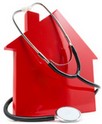


Methods To Prevent Accidental Falls In The Home:
Methods of preventing accidental falls in the home can include modifications of exercise routines, medications, and/or diet, treatment of health conditions that contribute to falls, prescribing assistive devices, or improving the patient's living environment.
Medication:
A review of the patient's medication should be performed, noting any potentially harmful side effects (especially side effects resulting from combining multiple medications). The following is recommended:
Try to eliminate any medications that are not absolutely necessary;
Limit multiple medication use;
Try to decrease chronic use of medications;
Use proper mobility aids (canes, wheelchairs, etc) while taking medication;
Use the lowest possible effective dosage of any medication.
A review of the patient's medication should be performed, noting any potentially harmful side effects (especially side effects resulting from combining multiple medications). The following is recommended:
Try to eliminate any medications that are not absolutely necessary;
Limit multiple medication use;
Try to decrease chronic use of medications;
Use proper mobility aids (canes, wheelchairs, etc) while taking medication;
Use the lowest possible effective dosage of any medication.
Vision Issues:
Proper treatment of visual disorders can reduce the risk of a fall. Be sure to treat any vision problems with a proper eye exam and/or corrective lenses. Take the proper time to adjust to new lenses, and be aware that during this period, a person is more likely to have a dangerous fall. If only reading glasses are necessary, be sure to remove them when walking about.
Proper treatment of visual disorders can reduce the risk of a fall. Be sure to treat any vision problems with a proper eye exam and/or corrective lenses. Take the proper time to adjust to new lenses, and be aware that during this period, a person is more likely to have a dangerous fall. If only reading glasses are necessary, be sure to remove them when walking about.
Dietary Considerations:
Proper nutrition and supplements can help prevent falls, as well as reducing potential injury from a fall. For example, an introduction or increase of calcium and vitamin D in the diet can improve a patient's bone density and mass. In addition, seniors who are undernourished have a greater risk of fractures due to a lack of fat or muscle to protect the bones during a fall. Nutritional requirements should be addressed on a case-by-case basis.
Proper nutrition and supplements can help prevent falls, as well as reducing potential injury from a fall. For example, an introduction or increase of calcium and vitamin D in the diet can improve a patient's bone density and mass. In addition, seniors who are undernourished have a greater risk of fractures due to a lack of fat or muscle to protect the bones during a fall. Nutritional requirements should be addressed on a case-by-case basis.
Exercise Programs:
Proper exercise is essential in preventing falls. Exercise can increase a patient's reaction time, bone density, balance, and mobility. Studies have shown that exercise can reduce the risk of a fall by up to 15%. Even mild aerobic activity such as mall walking, cycling, or stretching can have many beneficial effects.
Proper exercise is essential in preventing falls. Exercise can increase a patient's reaction time, bone density, balance, and mobility. Studies have shown that exercise can reduce the risk of a fall by up to 15%. Even mild aerobic activity such as mall walking, cycling, or stretching can have many beneficial effects.
Assistive Devices:
Assistive living devices such as canes, grab bars, or walkers can increase a patient's mobility and confidence, and decrease the risk of a fall. We cover these devices in more detail on this page: Independent Living Aids.
Assistive living devices such as canes, grab bars, or walkers can increase a patient's mobility and confidence, and decrease the risk of a fall. We cover these devices in more detail on this page: Independent Living Aids.
Improve The Safety Of The Patient's Living Environment:
Since most falls occur in or immediately outside the patient's home, some modifications may be required to reduce the risk of falls. Be sure to complete a home safety checklist, and follow through with the recommended improvements.
Since most falls occur in or immediately outside the patient's home, some modifications may be required to reduce the risk of falls. Be sure to complete a home safety checklist, and follow through with the recommended improvements.
Home | Contact Us | Sitemap | Privacy Policy | Medical Alert Basics | Medical Alert Reviews | Submit A Review | Home Safety | Accident Prevention Independent Living Aids | Independent Living Advice
Copyright 2008-2010 Medical Alert Reviews
Copyright 2008-2010 Medical Alert Reviews


More Medical Alert Resources On MedicalAlertReviews.Com:
Medical Alert Basics
Special Features Of Medical Alert Systems
Guide To Independent Living
Home Safety
Preventing Accidents In The Home
Special Features Of Medical Alert Systems
Guide To Independent Living
Home Safety
Preventing Accidents In The Home
